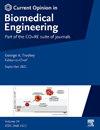Organoid bioprinting to pattern the matrix microenvironment
IF 4.2
3区 工程技术
Q2 ENGINEERING, BIOMEDICAL
引用次数: 0
Abstract
The development of organoid cultures has propelled the fields of cell biology, tissue engineering, and regenerative medicine forward. These cultures better mimic in vivo tissue structure and function compared to 2D cell culture; however, organoids are limited in size and do not inherently allow precise control over tissue architecture and cell heterogeneity. Hand-wrought organoid biofabrication approaches enable the production of larger and more complex tissues, but they still lack reproducible control of spatiotemporal tissue patterns. In contrast, bioprinting is a collection of machine-wrought technologies that are emerging as powerful tools in tissue engineering and disease modeling, but have not yet been widely applied to organoids. When combined with advances in biomaterials science, bioprinting offers the possibility to control spatiotemporal cellular and microenvironmental features. The interactions between biomaterial inks, support baths, and embedded cells provide the opportunity to guide the maturation and functionality of engineered tissues. This review describes how recent advances in organoid technology, bioprinting, and biomaterials science can be integrated to achieve spatiotemporal patterning of four aspects of the microenvironment: matrix structure and mechanics, matrix ligands and morphogens, co-culture of multiple cell types, and incorporation of vasculature. These insights underscore the potential for organoid bioprinting to advance the fabrication of in vitro tissue mimics for applications in drug screening, disease modeling, and regenerative medicine.
类器官生物打印以模拟基质微环境
类器官培养的发展推动了细胞生物学、组织工程和再生医学领域的发展。与二维细胞培养相比,这些培养物能更好地模拟体内组织结构和功能;然而,类器官在大小上是有限的,并且不允许对组织结构和细胞异质性进行精确控制。手工制作的类器官生物制造方法能够生产更大、更复杂的组织,但它们仍然缺乏对时空组织模式的可重复性控制。相比之下,生物打印是一种机器制造技术的集合,它正在成为组织工程和疾病建模的强大工具,但尚未广泛应用于类器官。当与生物材料科学的进步相结合时,生物打印提供了控制时空细胞和微环境特征的可能性。生物材料墨水、支撑液和嵌入细胞之间的相互作用为指导工程组织的成熟和功能提供了机会。本文介绍了如何将类器官技术、生物打印和生物材料科学的最新进展整合起来,以实现微环境的四个方面的时空模式:基质结构和力学、基质配体和形态原、多种细胞类型的共培养以及血管系统的整合。这些发现强调了类器官生物打印技术在药物筛选、疾病建模和再生医学中促进体外组织模拟制造的潜力。
本文章由计算机程序翻译,如有差异,请以英文原文为准。
求助全文
约1分钟内获得全文
求助全文
来源期刊

Current Opinion in Biomedical Engineering
Medicine-Medicine (miscellaneous)
CiteScore
8.60
自引率
2.60%
发文量
59
 求助内容:
求助内容: 应助结果提醒方式:
应助结果提醒方式:


